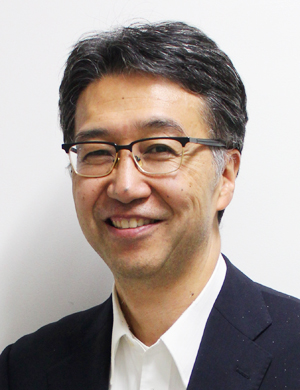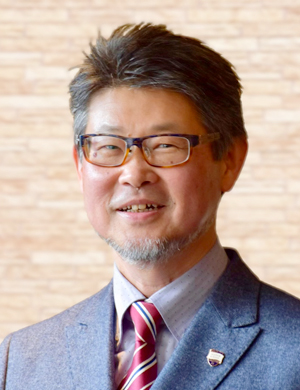Message from the 33rd General Chairperson
2019 was the 50th anniversary of Apollo 11 Moon Landing, and 2020 marks the 50th anniversary of the launch of Japan’s first artificial satellite “Osumi”. Space technology development, which started with the space race between the U.S. and the Soviet Union, has been used in many countries for a variety of purposes, including space science and exploration, Earth observation, space experiments and communication, and has contributed to the expansion of human knowledge and improving the quality of life. It goes without saying that broadcasting satellites, GPS, Quasi-Zenith Satellite System and Meteorological Satellites have become an indispensable part of social infrastructure in our daily lives. Furthermore, micro/nano-satellites that emerged at the beginning of the 21st century has radically lowered the “hurdle” for space technology development and space utilization, formerly monopolized by governments of large countries and large enterprises. With these new space assets, practical space activities has spread to universities, research institutes, small to medium enterprises, local governments, and emerging countries, while the space business, led by the private sector, including venture companies, has also expanded.
In addition, the U.S. has announced the Moon and Mars as the next targets for global collaboration and suggested to send humans to the Moon by 2024. Also, the scope of space utilization and space industry has expanded from around the Earth to the Moon and beyond, with the emergence of private enterprises and governments that have started human space flight program to Moon and Mars, or companies which want to explore and acquire space resources. The size of the global space-related industry is said to be 220 billion USD in 2016, and it is predicted that it will be 770 billion USD by 2050. Today, space has become extremely diverse in terms of activity areas, technologies, applications, players, and sources of investment, and the development and utilization of space has been accelerated through various schemes such as industry-academia-government collaborations as well as international collaborations. At the same time, it goes without saying that international agreements for the safe use of space, such as regulating space debris, have become increasingly important.
ISTS, first held in 1959, will celebrate 33 times in 2021. The Symposium, which originally started with an educational purpose to give an opportunity to students who cannot easily go abroad, has probably grown into the second largest international Symposium in the field of space with around 1,000 presentations. Researchers, engineers, and related personnel from all over the world in space engineering and science, space medicine, space law, and other related fields will participate in this Symposium. In addition to the collaboration with the Nano-Satellite Symposium, which has been joining since the 30th ISTS, we are planning to joint with the IAA’s Low-Cost Planetary Missions Conference and hope to make the conference even more international.
Although academic presentations and discussions are themselves important, it is far more important to make the most of the opportunity to bring together wonderful members from all over the world. We strongly hope that various business activities such as international negotiations, corporate PR, planning joint research, and policy discussions will start at this conference. We would like to thank Oita Prefecture and Beppu City for their sincere support, and hope that they will use this opportunity for their development in the areas of education and industry. We also look forward to receiving a variety of support and suggestions from companies that will also lead to expanding their business activities. We would be very grateful if ministries and government officials could use this conference as a forum for gathering space-related information and discussing strategies.
I sincerely hope that the 33rd ISTS Beppu in Oita Symposium “will be a chance to start something”, not only for the participants, but also for the organizers.
2019年はアポロ11号の月着陸から50周年目を迎え、2020年は日本初の人工衛星「おおすみ」打ち上げから50周年です。米ソの宇宙競争で始まった宇宙開発は、技術の進歩とともに多くの国で宇宙科学探査、地球観測、通信放送などさまざまな用途に使われるようになり、人類の知の拡大や生活の向上に貢献すべく発展してきましたが、いまや、放送衛星やGPS・準天頂衛星、気象衛星など生活に欠くことのできない社会インフラになっていることは言うまでもありません。さらに21世紀初頭から現れた超小型衛星が宇宙開発の「しきい」を根本的に下げ、大国の政府や大企業の独占であった宇宙利用が、大学・研究機関、中小企業、地方自治体、新興国に広がるとともに、多様なベンチャー会社をはじめとする民間主導による宇宙ビジネスも拡大してきました。さらに、アメリカでは、次の国際連携による探査目標として月とその先の火星が提示され、2024年までにもう一度、人を月面に着陸させる計画がアナウンスされました。また、火星への有人計画を始めた民間企業や政府、宇宙資源を探査・獲得しようとする企業も現れるなど、宇宙利用及び宇宙産業のスコープが地球周辺から月、そしてその先へと大きく広がってきました。世界では宇宙関連産業規模が2016年には24兆円といわれており、これが2050年には83兆円になると予測されています。いまや宇宙は、その活動場所、技術、利用法、プレーヤー、投資元が極めて多様化し、産官学の連携、国際連携などさまざまなスキームのもとでその開発と利用が加速されています。と同時に、デブリ規制など宇宙の安全な利用の確保をはじめとする国際的な取り決めがますます重要になってきたことは言うまでもありません。
1959年に第一回大会を開催したISTS(宇宙技術および科学の国際シンポジウム)も2021年には第33回を迎えます。もともとは、なかなか海外に行けない学生が英語で発表・議論する機会を与えるという教育目的からスタートしましたが、すでに1000件前後の発表を含む、おそらく世界で宇宙関係では2番目に発表数の多い国際会議に成長し、世界中から、宇宙工学・理学、宇宙医学、宇宙法、さらに関連する分野の研究者、技術者、関係者が一堂に会する場となっています。今回は30回大会から継続している超小型衛星シンポジウムとの共催に加え、IAAのLow-Cost Planetary Missions Conferenceとの共催も準備中で、より国際色の強い会議にしたいと考えています。
国際会議は、学術発表とそれをもとにした討論が重要な要素ではありますが、これだけのメンバーが世界中から集まる機会をそれだけに使うのはもったいないと考えています。そもそも、どんな研究をしているかの情報は、インターネットで簡単に検索できる時代であるからです。この貴重な機会を最大限活用し、商談や国際交渉、企業PR、共同研究の検討、政策議論など、幅の広い活動につなげてほしい、というのが私の強い思いです。当初よりご支援いただいている大分県、別府市のみなさまには、この場を提供いただいたことに心より感謝するとともに、ぜひこの機会を教育や産業面における、県や市のご発展に利用していただければと願っております。企業の方々からも、企業活動の拡大につながる、さまざまなご支援とご提案をいただくことを期待しております。そして、省庁はじめ政府関係の方々には、世界の宇宙関連情報の収集と戦略立案のための議論の場に使っていただければ幸甚です。
第33回ISTS別府大会が、参加者だけなく企画する方々にとりましても「何かが始まるきっかけ」となりますことを心より期待しています。
 |
|
| Prof. Shinichi Nakasuka, The University of Tokyo The 33rd ISTS General Chairperson 第33回宇宙技術および科学の国際シンポジウム(ISTS) 組織委員長 中須賀真一 |
Message from the 33rd Program Chairperson
Dear Friends,
as the Chairman of the 33rd ISTS Program Committee, please let me be allowed to mention a few words. As of May 2020, when I am writing this, it is under an emergency declaration issued by the Japanese government to prevent the spread of COVID-19 infection. We should work together to overcome this pandemic from which many people all over the world are suffering.
The 33rd ISTS will be held, jointly with the 10th Nano-satellite Symposium (NSAT) and the 13th IAA Low-Cost Planetary Missions Conference (LCPM), in Beppu City, Oita Prefecture from June 5 to 11, 2021. Oita Prefecture is located in the Kyushu region of Japan, and boasts the number one source of hot springs and the largest amount of spring water in Japan. In April 2020, Oita Airport (Kunisaki City) was selected for the first time in Asia as a space port for small satellite launch. Beppu City is located in the center of the east coast of Oita Prefecture and is the second most populous city in the prefecture. Known nationwide for Beppu Onsen, it is a tourist city visited by more than 8 million tourists every year.
It is my great pleasure to welcome you in such a scenic and powerful land. The theme of this ISTS is “Beppu in Oita: Beautiful Harmony of Earth and Space for Sustainable Future”. By “Earth” we are strongly aware of the ideal way of eco-conscious Energy Mix such as geothermal power generation being operated in this prefecture, and the economic activities directly connected to our lives. And by “Space” we are aware of new space business using ultra-small satellites and the expansion of the human frontier through space exploration. The sustainable future development of humankind will be realized by beautifully harmonizing these two concepts and I would like to share this theme with every participant of the ISTS in Beppu, Oita.
A variety of programs will be presented to you, including keynote speeches, World-Space Highlights, special lectures, and poster sessions in plenary format and, in parallel format, general and organized technical sessions, student sessions, as well as a control contest and a Gemstone project of young people. Various social programs will also attract you for sure.
Looking forward to seeing many of you at the 33rd ISTS,
皆様、
第33回ISTSプログラム委員会の委員長として、少しお話させていただきます。 2020年5月現在、私がこれを書いている時点で、COVID-19感染の拡大を防止するために日本政府によって発行された緊急宣言の下にあります。世界中の多くの人々が苦しんでいるこのパンデミックを克服するために私たちは協力して取り組む必要があります。
第33回ISTSは、第10回ナノ衛星シンポジウム(NSAT)および第13回IAA低コスト惑星ミッション会議(LCPM)と共同で、2021年6月5日から11日まで大分県別府市で開催されます。日本の九州地方にあり、温泉の数は日本一で、温泉量は日本一です。 2020年4月、アジアで初めて小型衛星打ち上げ用の宇宙港として大分空港(国東市)が選定されました。別府市は大分県の東海岸の中央に位置し、県で2番目に人口の多い都市です。別府温泉で全国的に知られ、毎年800万人以上の観光客が訪れる観光都市です。
そんな風光明媚でパワフルな土地で皆様をお迎えできることを嬉しく思います。今回のISTSのテーマは「大分別府:持続可能な未来のための地球と宇宙の美しい調和」。 「地球」では、本県での地熱発電などのエコミックスのあり方や、暮らしに直結する経済活動を強く意識しています。そして「宇宙」によって、私たちは超小型衛星を使用した新しい宇宙ビジネスと宇宙探査による人間のフロンティアの拡大を認識しています。人類の持続可能な未来の発展は、これら二つのコンセプトが美しく調和することによって実現され、このテーマを大分県別府ISTSのすべての参加者と共有したいと思います。
基調講演、World-Space Highlights、特別講演、ポスターセッションがプレナリー形式で、パラレル形式で、一般および組織化されたテクニカルセッション、学生セッション、コントロールコンテスト、若者のジェムストーンプロジェクトなどのさまざまなプログラムが計画されています。さまざまなソーシャルプログラムもきっとあなたを魅了することでしょう。
第33回ISTSで大分別府で多くの皆様とお会いできることを楽しみにしております。
 |
 |
| Prof. Toru Shimada, JAXA 嶋田 徹, JAXA教授 |
